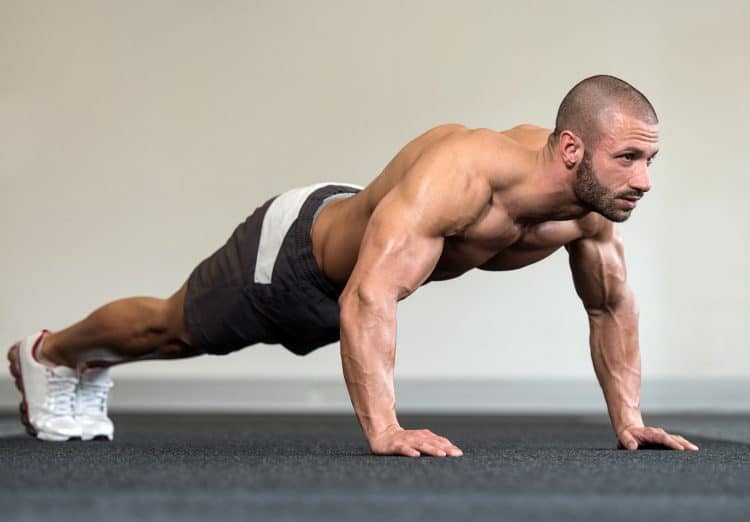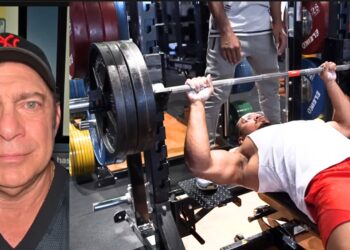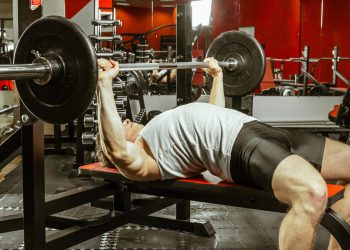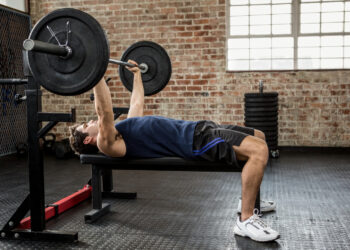The freeweight barbell bench press may be hailed as the king of chest exercises but we’d argue that Smith machine presses are better in many ways. So if you were ever under the impression that Smith presses (or any Smith machine exercise) are cheating because of some gym bro or an online forum, we’re here to bust that ridiculous myth and explain why it’s a must-have chest movement, how to maximize your pec gains, the best variations, and how to program it in your workouts.
How To Do Smith Machine Bench Presses
In this section, we’ve included detailed instructions for setting up the bench, proper body positioning and targeting the chest muscles safely and effectively. Smith machines should be used with extra caution as they do require a little more preparation time and attention to detail.
Step 1: Setting up for the press
Before you start, make sure that your bench is positioned evenly in the center of the machine between both rails. Then you want to lie on the bench with an empty bar and slide yourself forward or backward to find the ideal bar path in relation to your torso. We recommend unracking the unloaded bar and doing a few reps to find your setup. The bar should come down to your lower chest right around the nipple line or just below.
You then want to determine the right starting bar height for your arm length. This will allow you to un-rack the bar efficiently and without having to exert too much effort. Like the freeweight bench press, you want to be able to un-rack the bar and start with the arms fully extended.
The next very important step especially if you’re lifting heavy loads without human assistance is to set the spotter arms in place. They should be low enough to give you a full range of motion but high enough to give you a little space to get out from under the bar in the event that you need to bail the weight.
Step 2: Hand width and grip
Now that you have the bench and bar in place, it’s time to set yourself up for a perfect press. Keep in mind, there are different body types and arm lengths.
Level Up Your Fitness: Join our 💪 strong community in Fitness Volt Newsletter. Get daily inspiration, expert-backed workouts, nutrition tips, the latest in strength sports, and the support you need to reach your goals. Subscribe for free!
Pro tip: To find your hand placement on the bar, press your upper arms into your sides then move them out at a 70-75 degree angle to your torso. Now reach up and grab the bar. Do a few practice reps and adjust slightly if needed but not that much.
We recommend using a full grip with the thumbs wrapped around the bar, however, more advanced exercisers may prefer to use a thumbless grip.
Step 3: Placing your feet
Your feet play an important role in bench press performance because they help to give you a solid base, stability, and additional pushing power. While bench pressing foot position can sometimes vary depending on one’s preference and comfort, most people will get the best results by planting their feet flat on the ground under the knees.
If your feet are too far forward, you cannot possibly get enough leverage to push. Likewise if they’re too back, you’ll be pressing on your toes and give up a lot of power assistant.
Step 4: Shoulder retraction and lat engagement
If you want to get the most out of your bench press efforts, it is imperative that you have a checklist to ensure you’re setting up in a way that will maximize your pushing performance. After the bench and bar are in place, you’re ready to fire up the muscles that will assist in the press.
To do this:
- Retract your shoulders into the bench, stick your chest up and flare your lats out. This will create a natural arch in your lower back and press the upper back down into the bench, giving you a solid base that acts as a counterforce as you press the bar in the opposite direction. You need to have completed all of the above steps before you un-rack the bar and begin the bench press.
Step 5: Lower and Press!
Now you’re in position and ready for the press.
To do it:
- Rotate your wrists to un-rack the bar and push it up toward the ceiling until your elbows are fully extended.
- Now lower the bar down until it touches your lower chest/nipple area and inhale.
- Then contract your chest muscles and use your triceps to press the bar back up to full arm extension while exhaling.
- Repeat for the desired number of repetitions and then try to re-rack the bar on the same spot that you un-racked it.
Pro tip: If you have limited shoulder mobility, try to lower the bar to within at least three inches from your chest for decent pec activation.
Read also: How To Do The Smith Machine Incline Bench Press
Common Mistakes
If you can avoid making these key mistakes, the Smith bench press can give you the gains you’re looking for.
Facing the wrong direction
This more specifically applies to Smith machines with angled rails. A proper bench press is not moving the bar up and down in a vertical path. It’s not natural or efficient. To do a bench press the correct way, you un-rack the bar and hold it above the shoulders then bring it down to the lower chest (nipple area), before pressing it back to the starting un-racked position in an arc like motion. Therefore, when setting up on an angled machine, the rails should have an upward slope from the lower to upper chest.
Setting the bar too high
A common mistake is placing the bar too high on the hooks so when you go to un-rack it your arms are almost fully extended and you have to lift your upper body to get it off the hooks. This starts you off in a bad position and it’s dangerous for your wrists. Set the bar so that when you grip it, your arms are roughly 3/4 of the way to full elbow extension.
You also don’t want the bar too low especially if you’re lifting heavy because you’ll have to exert too much effort to press it up. It’s always easier to start from an arms extended position.
Uneven sides
If the bench is uneven between the machine rails, one side of your body will be working harder than the other. Take your time to ensure the bench is even before performing the bench press.
Pro tip: Ask another set of eyes to look at the bench and make sure it’s evenly positioned.
Using bad form
While a Smith press will be a little different than the free bar press, you still need to set up the same. Go through the checklist and follow the step-by-step instructions above to ensure you’re properly positioned for a strong and safe press.
Arching your back too much
Powerlifters typically use a technique where they arch the back excessively to minimize the distance between the bar and their chest because it allows them to lift more weight. This is not recommended for most gym goers trying to gain size and strength. Your back will naturally arch if you’re setup correctly.
Speeding through reps
A fixed bar is not an excuse to speed through reps without paying attention to form. But many people do it. You don’t have to go at a snail’s pace but slow things down and feel the muscles working.
4 Smith Bench Press Benefits
Why would you choose the smith bench press as a substitute for the freeweight variation? Here are three reasons.
1. No need to balance or stabilize
A heavy advantage of the smith or any machine exercise is that you don’t have to worry about balancing a barbell or stabilizing your core to keep it in place (you still need to stabilize the spine during Smith machine presses though). Anyone who uses this machine regularly knows how nice it is to not have to put in the extra effort to keep the bar in position. It’s almost a relaxing variation of the bench press although you still need to push with intensity.
Should you completely replace the freeweight version? Not at all as both have their pros and cons.
Related: 8 Ways to Boost Your Bench Press
2. May be better for pure strength gains
Some people may not agree but the balance and stabilization requirements with freeweight movements typically means you won’t be able to lift as much. When it comes to machine exercises, you’re able to get under the weight and focus strictly on moving it.
Level Up Your Fitness: Join our 💪 strong community in Fitness Volt Newsletter. Get daily inspiration, expert-backed workouts, nutrition tips, the latest in strength sports, and the support you need to reach your goals. Subscribe for free!
That leads us to another benefit…
3. No spotter required
Smith machines typically win in the safety category when it comes to not crushing your chest with a heavy barbell unless you’re using spotter arms in a power rack or something similar. You can use safety hooks on a Smith so that the bar will stop just above your chest and this is a huge deciding factor for many exercisers.
4. Good option for beginners
A 44-pound barbell can be too heavy for a lot of beginners to start with, hence why we like the Smith bench press in this instance. We’re not saying it has all the benefits of a freeweight press but it is performed from a lying position and using a long bar. So at least you’ll be in the same position and from there you can learn correct pressing technique and body mechanics.
Drawbacks
What are the less desirable traits of Smith bench presses?
Not as accessible compared to a freeweight barbell and rack
One major drawback of Smith presses is that, well, you need a Smith machine. If you train at a gym then it’s no issue but most people who train at home will have a freeweight setup because it’s typically much more affordable.
Does not allow for natural movement patterns
While Smith bench presses are one of our favorite chest exercises, they can be restricting depending on which one you have access to. The proper way to do a freeweight barbell bench press is to push the bar up in arc shaped motion. A standard Smith machine with a vertical rail will not allow you to do that although, that doesn’t necessarily mean it won’t be effective or comfortable for the person pushing the bar.
But there are angled and free moving Smith machines that will allow you freer movement.
Requires a little more setup time
While it shouldn’t be a dealbreaker, Smith machines typically don’t come with benches attached. Which means you’ll need to set the bench up under the bar evenly on both sides and perfectly aligned with where you want the bar to be in relation to your chest.
Variations and Alternatives
Variety and options makes training exciting and effective but we’d go as far as to say that using different angles and equipment is important for maxing out your progress. Check out these Smith bench press variations and alternatives that we prefer.
1. Reverse grip Smith bench press
Try switching your grip position from time to time. You may actually feel a better chest contraction using an underhand rather than overhand hand position.
Why is that? One explanation could be that we tend to move our hands closer together on the bar when using a supinated grip, possibly pre-engaging the chest fibers a little better before each rep.
2. Varied width Smith bench press
Move your hands closer together to activate more of the triceps and get a better contraction in the chest fibers, or spread them further apart for a superior pec stretch and the ability to move heavier weight. Varying up the width of your grip is also one of the best ways to shift the workload and each has its advantages.
3. Decline Smith bench press
To emphasize more of the lower sternal chest fibers, you can setup a decline capable bench under the Smith machine. The advantage of doing it this way instead of freeweight style is the bar will not move and sway.
4. Alternative chest press machine
While Smith presses are the closest machine replication of a freeweight barbell press, please do take advantage of the other chest press machine offerings at your gym. While there are no replacements for barbell and dumbbell chest presses, we’d rather you find what feels good to you. While your form will ultimately dictate the feel of a movement, certain variations just feel better.
5. Freeweight bench press
All those funny chest day memes are based on one exercise and that is none other than the barbell bench press. It is the standard by which upper body strength is measured and nothing can take its place. Does that mean it’s the best chest exercise? Well, there are a lot of factors that you’d have to consider before making that claim.
However, a study conducted by the American Council on Exercise (ACE) found that the freeweight barbell bench press resulted in 100% chest muscle activation using electromyographic (emg) technology.
It was concluded that for this study, the bench press was found to be the superior pec builder when compared to eight other variations including the pec deck, cable crossovers, chest press machine, inclined dumbbell fly, dips, and push-ups (suspended, stability ball, and standard), respectively (1).
Utilize these 15 Best Barbell Bench Press Variations for a stronger press.
6. Push-ups!
What’s the best exercise to train your chest without weights, machines or any equipment? The push-up hands down! This classic bodyweight movement comes in a variety of options from the basic push-up to angled, weighted, and modified versions that will do everything a Smith machine bench press can do for you.
Read: 12 Reasons To Do Push-Ups Every Day
How Much Does A Smith Machine Bar Weigh?
While it’s not exactly relevant as long as the bar supports your workouts, most, if not all gym bros and gals have at some point wondered how much a Smith bar weighs compared to the common 20 kilograms or 44 pounds freeweight bench press barbell.
Smith machines typically weight anywhere between 7-30 pounds depending on the variation. Learn more about Smith machine bar weight here.
Smith Machine Vs. Freeweight Bench Press
Let’s preface this section by saying one is not necessarily better than the other. Each has its advantages and disadvantages depending on a variety of factors. Here are some of the differences and a comparison between these two compound chest exercises.
- Smith machine – Bar is locked into the machine rails and moves along a fixed, predetermined path. Wide range of bar weights and machine variations. More complex design. Great for pure strength and hypertrophy.
- Freeweight version – Bar moves freely in space and needs to be stabilized during each repetition. 44-pound barbell is standard for most setups. More simplistic design. Awesome for building overall chest strength/stabilizer muscles, hypertrophy, and muscular endurance.
How To Program Smith Machine Presses in Your Workouts
The Smith machine press is a compound, multi-joint chest movement. That means you should place it first at the very beginning of your pec-focused sessions when you’re fresh and at your strongest. This will allow you to lift the most weight and overload your upper body pushing muscles for maximum strength and muscle gains.
When should you swap freeweight bench presses for the Smith machine variation?
A Smith machine bench press will give you similar results to its freeweight counterpart and it’s an excellent substitute. In fact, some people will find it to be a better alternative because they feel it better in the chest.
Some other ways to include Smith presses are on those days when you’re less energized, feeling off, or even when you’re recovering or coming back from an injury (not medical training advice).
Sets and Reps
Smith presses are an awesome multi-use chest exercise due to the simple fact you’re locked into a fixed bar path. Therefore, you can focus on completing your reps without having to battle against stabilizing a free moving barbell.
- Strength: 2-4 sets x 4-6 reps
- Hypertrophy: 2-4 sets x 8-12 reps
- Muscle hypertrophy and endurance: 3 sets x 15+ reps
Muscles Worked
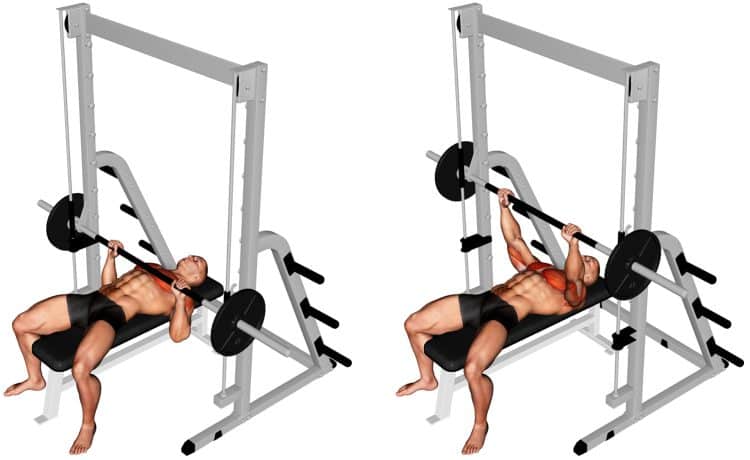
- Pectoralis Major Sternal Head – The chest has sections of muscle fibers each of which contribute to different functions of the upper torso. The lower or sternal head allows for various specific movements such as arm extension, shoulder adduction/ internal rotation, and scapular depression and protraction.
- Pectoralis major clavicular head – The clavicular or upper chest muscles are just below the clavicle bone and its fibers run down and diagonal toward the armpits. These fibers move the arms forward (flexion). A flat press will work the lower and upper fibers to a similar degree.
- Triceps brachii – A three headed muscle on the posterior upper arm, your triceps help to push objects away from your body (e.g., Smith bench press) and support your body weight during exercises like dips, push-ups, etc. Triceps are a larger muscle group than your biceps.
- Deltoids anterior – Just like the triceps, the deltoids have three heads – anterior (front), lateral (side) and posterior (rear). While they all have different functions, the anterior head is responsible for flexing the arm by moving it forward.
- Core muscles – Also known as your midsection or trunk, the core consists of your abdominals (crunching movements and spine stability), obliques (twisting and rotation), and spinal erectors (standing up from bent over or leaning back).
Bottom Line
If you want to increase your pressing and build solid chest muscles, the Smith bench press should have a place in your upper body rotation. While not a do-all pec movement or freeweight replacement, machine exercises do offer advantages that other training methods don’t and that means better strength gains.
Interested in measuring your progress? Check out our strength standards for Bench Press, Push Ups, Smith Machine Bench Press, and more.

